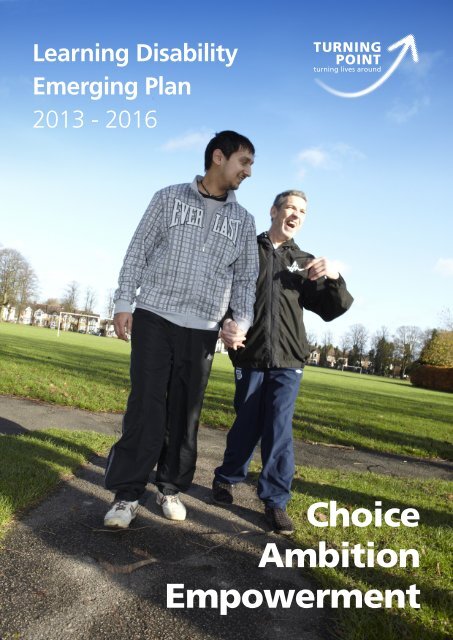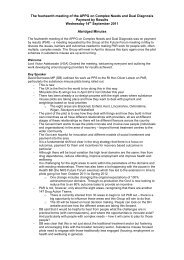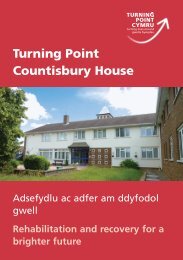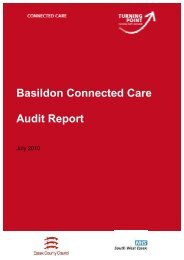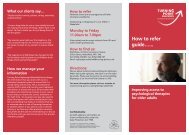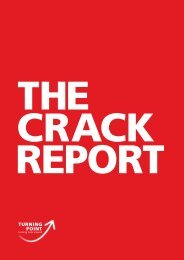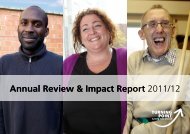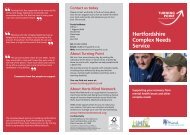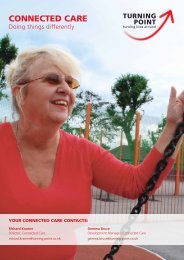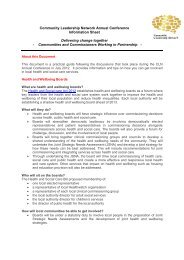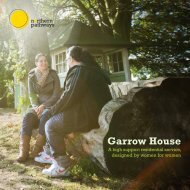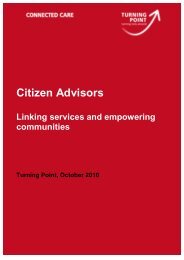Learning Disability Emerging Plan - Turning Point
Learning Disability Emerging Plan - Turning Point
Learning Disability Emerging Plan - Turning Point
You also want an ePaper? Increase the reach of your titles
YUMPU automatically turns print PDFs into web optimized ePapers that Google loves.
<strong>Learning</strong> <strong>Disability</strong><strong>Emerging</strong> <strong>Plan</strong>2013 - 2016ChoiceAmbitionEmpowerment
<strong>Turning</strong> <strong>Point</strong> <strong>Learning</strong> <strong>Disability</strong> <strong>Emerging</strong> <strong>Plan</strong> 2013 - 2016<strong>Learning</strong> <strong>Disability</strong><strong>Emerging</strong> <strong>Plan</strong>2013 - 2016Empowering people to lead their own lives withambition through choice and controlThis document sets out the 3-year strategic plan for the <strong>Learning</strong> <strong>Disability</strong> BusinessUnit in <strong>Turning</strong> <strong>Point</strong>. The plan responds to the 2012-17 corporate strategy and willbe updated on an annual basis. This plan should be seen as fluid due to continuallychanging landscapes2
<strong>Turning</strong> <strong>Point</strong> <strong>Learning</strong> <strong>Disability</strong> <strong>Emerging</strong> <strong>Plan</strong> 2013 - 2016ContentsExecutive Summary 3How this Strategy was developed 3National Picture 3The External Environment 5Our Competitors 12Current Provision 13Our Way Forward 17Conclusion 19Action <strong>Plan</strong> 20Appendices 24References 283
<strong>Turning</strong> <strong>Point</strong> <strong>Learning</strong> <strong>Disability</strong> <strong>Emerging</strong> <strong>Plan</strong> 2013 - 2016Executive SummaryThe <strong>Learning</strong> <strong>Disability</strong> Business Unit faces many external challenges over the period of this strategy: meeting theneeds of individuals as they age, increasing funding pressures and changes to the way services are commissionedto name a few. The way we respond to these forces will re-shape the way our services are designed anddelivered while also influencing the way <strong>Turning</strong> <strong>Point</strong> learning disability is viewed nationally.<strong>Learning</strong> disability provision going forward will need to incorporate a focus on quality; delivering value formoney; exploration of new technologies and means by which services can be made more efficient to delivermore for less; and ensuring service user involvement in every part of the services’ design and delivery. Thesechanges provide opportunities for the Business Unit to work creatively to provide the solutions commissioners,individuals and families will and are increasingly demanding. We will therefore need a flexible marketingapproach; clarity on the business unit’s unique selling points and the ability to demonstrate outcomes like neverbefore.How this strategy was developedWhen <strong>Turning</strong> <strong>Point</strong>’s corporate strategy was developed in 2012, each business unit developed their owncomplementary specialist strategy (relating to mental health, substance misuse, <strong>Turning</strong> <strong>Point</strong> Too and learningdisability). However, with the changes in the leadership of the <strong>Learning</strong> <strong>Disability</strong> Business Unit and shiftingpolicies in the learning disability field externally, it felt like a good time in late 2012 to review our position anddetermine our future priorities and direction.This plan was developed from input by the staff, family carers and people who have learning disabilities fromeach of the seven areas in which <strong>Turning</strong> <strong>Point</strong> runs learning disability services. Each region held a series ofworkshops, focusing on a set of questions posed by the new managing director (Appendix 1). A workshop wasalso held for the senior management team to gain their views to a similar set of questions. Over 60 people wereinvolved in the plan’s development.This co-production with our stakeholders is an important first step in the way that <strong>Turning</strong> <strong>Point</strong>’s learningdisability services will be driven in the future. We want this commitment to lead to greater leadership, ownershipand understanding from within the services, rather than a top down approach. Involvement is at the heart of thisstrategy and what better place to start than the plan itself. The strategy discusses national trends, priorities andpressures and then tells the <strong>Turning</strong> <strong>Point</strong> story of current services, the vision for future service provision and theaction we will need to take to keep ahead of the game with fresh and sustainable services meeting real need,whilst pressing for more national change from Government.The plan directly links to <strong>Turning</strong> <strong>Point</strong>’s corporate plan.4
<strong>Turning</strong> <strong>Point</strong> <strong>Learning</strong> <strong>Disability</strong> <strong>Emerging</strong> <strong>Plan</strong> 2013 - 2016challenge faced by the sector which must be addressed as 20-25% of young people currently in transition fromchildren to adult services are from BME communities iv . Access for this group was flagged as a priority in ValuingPeople Now which stated that 75% of people within this group are struggling without support. It is often saidthat this group face ‘double discrimination’ as they experience ‘insufficient and inappropriate services causedby policy and services are not always culturally sensitive.’ Wrong assumptions about what certain ethnic group’svalue are made and language barriers are not overcome. This means that they face discrimination in terms ofboth ethnicity and disability v .Many people from BME groups are unsure of what services are available for them and services are ill-equipped toaddress this barrier.Overall, trends indicate that vi :• n The estimated average annual increase in the need for social care services for adults with learningdisabilities over the period 2011 – 2030 is 3.2% (varying from 1.2% to 5.1% depending on theFairs Access to Care (FACs) criteria applied.) This equates to between an additional ‘49,000 to116,000 adults with learning disabilities over the next ten years’• n Approximately 25% of new entrants to adult social care with learning disabilities will belong tominority ethnic communities• n Approximately one in three of new entrants will come from a home in which the child is eligible forFree School Meals• n By 2030 the number of adults aged 70+ using social care services for people with a learningdisability will more than double indicating a rise from 1,900 in 2011 to 5,000 in 2030For all estimates the annual percentage growth rate slows from 2011-2018/19 at which point it stabilises – apattern reflecting changes in birth rates over the last twenty years.TURNING POINT’S PERSPECTIVE:We should ensure that we are flexible enough to reach out and offer supportto people from all backgrounds. Especially as we have staff who understandpotential cultural and religious needs. We will focus on offering a wide range ofsupport to people from BME communities.6
<strong>Turning</strong> <strong>Point</strong> <strong>Learning</strong> <strong>Disability</strong> <strong>Emerging</strong> <strong>Plan</strong> 2013 - 2016The External EnvironmentPeople with a learning disability are living longer. Alongside an ageing population this changing demographymeans there will be increased pressures on the social care system it is neither designed, nor funded to cater for.Government PolicyBelow are the principal drivers influencing our future planning and delivery of learning disability services, as wellas the priorities of our commissioners.1. Financial PressuresVast reforms are happening at a time of reducing budgets and unprecedented financial pressure being placedon providers. Many are struggling already to meet the demands of commissioners in terms of frontline cuts andthere is concern that this will drive quality down.A <strong>Learning</strong> <strong>Disability</strong> Observatory report vii highlights that changes in demand are likely to outstrip changes inneed due to a variety of factors ‘combining to reduce the capacity of informal support networks to providecare.’ Factors include increases in the percentage of older people with learning disabilities (whose parents arelikely to have died or be very frail) and changing expectations among families regarding the person’s right to anindependent life.The way the current system is funded has long been seen as unsustainable. There has recently been a consensusreached that care costs will be capped at £75,000 per person. This provides some indication to local authoritiesof how much they will be expected to provide, versus individual contributions.This conclusion, however, offers little reprieve as we know from the Comprehensive Spending Review thatLocal Authorities have been tasked with 7.1% annual cuts totalling an average of 28% by 2014-15. Weknow austerity measures will now continue to 2017 at least. We also know that many authorities have madesignificantly higher savings than 7.1% per year and are under increasing pressure to go beyond the 28%total. Many of these cuts are being passed directly to front line services so organisations like <strong>Turning</strong> <strong>Point</strong> willincreasingly be expected to do more for a lot less without compromising on quality, whilst ensuring delivery isservice user and family led.Current spendPublic spending on social care was projected to be £15.3billion in 2010/11. In 2010/11 the largest componentof local authority expenditure on residential services for people with learning disabilities was on residentialcare placements (£1.5bn) followed by supported or other accommodation (£483m) and nursing care (£75m).Supporting People expenditure in 2010/11 was £149m. Taking inflation into account local authority expenditureon supported and other accommodation increased from 2005/6 to 2010/11 by 17% per year whereas residentialcare spend has decreased by 1% per year. Current Comprehensive Spending Review cuts are increasing thisreduction in residential care viii . Research by the <strong>Learning</strong> <strong>Disability</strong> Observatory found that spend in 2010/11 onpeople with a learning disability by the NHS and local authorities jointly varied between £34,000 per person and£41,000 per person. The average was £36,680 ix :7
<strong>Turning</strong> <strong>Point</strong> <strong>Learning</strong> <strong>Disability</strong> <strong>Emerging</strong> <strong>Plan</strong> 2013 - 2016Future spendWithout a finalised forward funding programme in place, estimating future spend is difficult. According to theNuffield Trust x the below variation exists between current spend and, if the Dilnot proposals are accepted, intheir current form.We also have to consider Payment by Results. PbR is already being introduced across mental health, substancemisuse, employment and the criminal justice system. In the latest (October 2012) guidance from the DH, there isreference to PbR being introduced into NHS funded LD provision.The landscape is therefore one where we need to deliver more for less while not compromising on quality. Thiswill only be achieved through innovative solutions, developing partnerships with other organisations; the use oftechnology and a more flexible approach to service delivery whose outcomes are evidenced.8
<strong>Turning</strong> <strong>Point</strong> <strong>Learning</strong> <strong>Disability</strong> <strong>Emerging</strong> <strong>Plan</strong> 2013 - 2016TURNING POINT’S PERSPECTIVE:High quality services with meaningful service user involvement will be thecornerstone of our approach. In such a difficult financial time, we will build thestrongest dialogue and partnership with commissioners so we can balance thechange demanded by financial realities against our commitment to high qualityservice delivery.In the climate we are entering, all providers will have to recognise if they arereaching the point when the money being provided is no longer enough tocontinue delivering a high quality service. <strong>Turning</strong> <strong>Point</strong> will develop a matrixof indicators to help us identify if this point is being approached, and to makemeasured timely decisions about how to proceed with the contract in question.2. Health and Social Care ReformsReforms to the NHS and wider care and support services are changing the way services are designed anddelivered. The Health and Social Care Act (2012) and forthcoming Care and Support Bill enshrine much of thegovernment’s aims in law, namely;• n Focus on people’s wellbeing and keeping them independent for as long as possible• n Greater national consistency in access to care and support• n People having the information to make choices about their care• n People having more control over their care• n Improved support for carers• n Improved quality of care and support• n Improved integration of different services around individual’s needs• n A duty on local authorities to provide information and advice, prevention services and shape themarket for care and support services• n Clear legal entitlements to care and support, including giving carers a right to support putting themon the same footing as the people they care for• n Everyone (including carers) should have a personal budget (PB) as part of their care and supportplan. The Care and Support Bill states everyone will be offered a PB and have the right to take thisas a direct payment• n New duties to ensure that no-one’s care and support is interrupted when they move from one localauthority area to another• n A new statutory framework for adult safeguarding, setting out the responsibilities of localauthorities and their partners, and creating Safeguarding Adults Boards in every areaTURNING POINT’S PERSPECTIVE:We will continue to engage, speak out and influence to positively shape theexternal policy environment affecting people with a learning disability.9
<strong>Turning</strong> <strong>Point</strong> <strong>Learning</strong> <strong>Disability</strong> <strong>Emerging</strong> <strong>Plan</strong> 2013 - 20163. The response to Winterbourne ViewThe spotlight has very much been, and will continue to be on quality. In its final report on WinterbourneView, the Government sets out a programme of action to transform services so that people no longer liveinappropriately in hospitals. Instead, individuals should be cared for in line with best practice, based on theirindividual needs and in a way that ensures their wishes, and those of their families, are listened to and placed atthe heart of planning and delivering their care.The report makes clear that there are wide ranging actions required by many organisations that result fromWinterbourne (see Appendix 2 for a summary).TURNING POINT’S PERSPECTIVE:We will not engage in new independent forensic hospital based provision. We willhowever focus on offering the least restrictive practices to this group of people –step down from hospital provision to intensive supported living with wrap aroundsupport.4. Community based servicesAs part of the government’s commitment to community based provision, we are likely to see a reduction inresidential care and an increase in supported living contracts and innovative day opportunities.a. AccommodationOf the 138,995 adults with learning disabilities reported by local authorities to be in some form ofaccommodation in 2010/11:• n 29.6% (41,205 people) were reported to be living permanently with family or friends• n 81,985 adults (59% of the total number in some form of accommodation) were reported to be inpermanent accommodation in 2010/11This group were most likely to be living in:• n registered care homes (23,465 people; 16.9% of the total)• n supported accommodation/supported group homes (17,610 people; 12.7%), or• n some form of tenancy (17,405 people; 12.5%) xiThese numbers represent increases from 2009/10 - 2010/12 of adults in sheltered housing (5.5% increase),tenancies with a private landlord (8.1%) or temporary accommodation (76.6%).For the same period there was a decrease of:• n 5.5% in the number of adults in registered care homes• n 19.3% in acute/long stay healthcare• n 29.5% in the number of adults in registered nursing homes• n 15.1% in owner occupier/shared ownership housing10
<strong>Turning</strong> <strong>Point</strong> <strong>Learning</strong> <strong>Disability</strong> <strong>Emerging</strong> <strong>Plan</strong> 2013 - 2016• n 7.1% in LA temporary accommodation• n 16.1% less people staying with family/friends as a short term guestTURNING POINT’S PERSPECTIVE:People living with families still represent a large proportion of the population.Many living with older families may themselves be struggling with their ownhealth. We will seek a commissioner partner to develop a multi-disciplinary teamto work with families in a specific locality before they reach crisis. We would lookto work with black and minority ethnic families in particular as these groups arelargely not well supported at present.We will aim to transition the individual with a learning disability towards moreindependent living at their pace but before their existing family situation breaksdown due to illness, personal circumstances etc.b. Day OpportunitiesAs well as residential services, day opportunities have also seen changes. There is pressure to change the way dayservices are run and many have seen their funding vastly reduced; 52,150 adults used local-authority funded dayservices in 2010/11, a 2% reduction since 2005/6 xii . This is seen in policy context as still needing to reduce withan emphasis on meaningful activities, support into employment and occupation rather than large day centretype services.c. EmploymentEncouraging people with a learning disability into paid employment forms part of the current welfare reformsbeing implemented and is an area where <strong>Turning</strong> <strong>Point</strong> has demonstrated expertise. There are a number ofinitiatives, including Access to Work schemes, specifically designed for people with a learning disability to accessemployment.According to the Labour Force Survey, disabled people remain far less likely to be in employment than nondisabledpeople. In 2012, 46.3% of disabled people were in employment compared to 76.2% of non-disabledpeople. The most commonly used number for people with a learning disability in employment is between 7%and 16.7% xiii with the Foundation for people with a learning disability stating that 65% want to work. This isincreasingly likely to become an outcome commissioners are pressed to monitor and if payment by results wasto be introduced into social care learning disability provision employment would likely be a result payment waslinked to.d. Hospital re-provisionHospital provision is expensive. The government has closed NHS campuses and is committed to reducing hospitaladmissions and keeping people in their homes for as long as possible.From the last Count Me In xiv survey we know that in 2010 there were 3642 people with a learning disabilitywho were inpatients at either NHS or independent sector hospitals in England and Wales. 13% were from BMEgroups. There were lower than average admissions among Indian, Pakistani, Other Asian, Black African andChinese individuals. 67% of patients had been in hospital for one year or more, 31% for more than five years.11
<strong>Turning</strong> <strong>Point</strong> <strong>Learning</strong> <strong>Disability</strong> <strong>Emerging</strong> <strong>Plan</strong> 2013 - 2016The proportion of inpatients in independent healthcare organisations increased from 20% in 2006 to 33% in2010. This is likely to be a result of closing NHS campuses, with people moving from hospital to communitysettings.Many people are in hospitals needlessly and therefore step down services, of the kind <strong>Turning</strong> <strong>Point</strong> can provide,are crucial to ensure people get the support they need in the community.TURNING POINT’S PERSPECTIVE:Our focus will be to expand services for individuals with complex needs movingout of NHS/independent hospital provision into less restrictive (but still specialist)accommodation and support. The drive to reduce acute assessment and treatmentunits means that we are well placed to develop our expertise in enabling peoplewith complex needs moving on to lead more independent and fulfilled lives.5. Health IssuesIt is well known that people with learning disabilities die younger than the general population. They are 58 timesmore likely to die before the age of 50 and 4 times more likely to have a preventable cause of death xv .Their health needs can be complex with many having more than two major co morbidities.Reducing mortality rates of people with a learning disability are also included in both the Clinical CommissioningGroups (CCG) and NHS Outcomes frameworks for 2013/14.TURNING POINT’S PERSPECTIVE:People struggle more to enjoy and participate fully in life if their health isimpeded. <strong>Turning</strong> people’s lives around will also mean ensuring people’s health isthe best it can be. For these reasons we will focus on the health of people with alearning disability and ensure that everyone has a health action plan to meet theirspecific health needs.6. Eligibility CriteriaEligibility Criteria, as part of the review on funding is being revised. With increasing financial pressures, thereare already examples of local authorities only funding services for those with critical needs, with the majorityfocusing on critical and substantial needs only. In the Care and Support Bill, the Government intend to establisha single threshold for defining eligible needs. The likely result is that the minimum national eligibility thresholdwill be set at a point equivalent to the current substantial category. This means that less preventative work willbe commissioned and undermines the Government’s commitment to keeping people independent for as long aspossible.12
<strong>Turning</strong> <strong>Point</strong> <strong>Learning</strong> <strong>Disability</strong> <strong>Emerging</strong> <strong>Plan</strong> 2013 - 2016Table 1:Severity Of <strong>Learning</strong> <strong>Disability</strong> of Predicted New Entrants To Adult Social Care Between 2011 And 2030 xviSeverity of <strong>Learning</strong> <strong>Disability</strong>Lower estimate (critical orsubstantial needs only)Upper estimate (critical,substantial or moderate needs)Mild/Moderate 24.4% 71.1%Severe 55.3% 22.3%Profound Multiple 20.3% 6.6%7. Transitiona. Child to AdultOver 70,000 children in England have a Statement of Special Educational Needs (SEN) and a primary SENassociated with learning disabilities. Of these, just over half have a moderate LD, one third have a severe learningdisability and just over one in ten have profound multiple learning disabilities.There are approximately 200,000 children in England at the School Action Plus stage of assessment of SEN orhave a Statement of SEN and a primary SEN associated with LD. Out of these 4/5 have a moderate learningdisability, one in twenty have profound multiple learning disabilities xvii .There is still significant improvements to be made in the transition of young people to adult services and theHealth and Social Care Act begins to address some of the issues by giving local authorities a duty to conductneeds assessments for adult care and support, ahead of a child’s 18th birthday where required. Given thenumbers of young people with a learning disability and the fact people are living longer, transition services andsupport for young adults is vital to get right to prevent issues arising in adulthood.b. Adult to Older AdultsThe crux of the social care reforms is the ageing population and the unsustainable nature of the current fundingTURNING POINT’S PERSPECTIVE:We shall look to develop good services for young people to move into adulthood,looking at individuals from the age of 14 onwards. In particular, we wouldanticipate piloting a summer camp for young people with complex needs.system. Current population figures show that there are currently 10 million people in the UK over 65. In the next20 years that figure is due to more than double.Fortunately, people with a learning disability are also living longer. Recent estimates state that by 2030 thenumber of adults aged over 70 using social care services for people with learning disabilities will also more thandouble.Issues around coordination of older people’s services exist which we could be well placed to help address,given the numbers of older people we already support. Issues include the lack of coordinated response across13
<strong>Turning</strong> <strong>Point</strong> <strong>Learning</strong> <strong>Disability</strong> <strong>Emerging</strong> <strong>Plan</strong> 2013 - 2016local areas, people living with their families may not be known to the system until a crisis point is reached andtransition plans into old age are not universally in place.Older people with learning disabilities are at higher risk of increased health problems in later life due to levelsof unmet need and inequalities that exist within the health system. There are also age related health risks,for instance people with Down’s Syndrome are at higher risk of developing Alzheimer’s and at an earlier age.Although this is known, people with a learning disability who develop dementia are less likely to receive a corrector early diagnosis even those often experience a more rapid progression of dementia.Studies show that the numbers of people with Down’s Syndrome who have Alzheimer’s disease areapproximately:• n 1 in 50 of those aged 30 to 39 years• n 1 in 10 of those aged 40 to 49 years• n 1 in 3 of those aged 50 to 59 years• n More than half of those who live to 60 or overThe numbers of people with learning disabilities other than Down’s Syndrome who have dementia areapproximately:• n 1 in 10 of those aged 50 to 65• n 1 in 7 of those aged 65 to 75• n 1 in 4 of those aged 75 to 85• n Three-quarters of those aged 85 or overThese numbers indicate a risk about three to four times higher than in the general population xviii .8. CommissioningTURNING POINT’S PERSPECTIVE:We shall develop more services that are specifically designed for our ageingpopulation looking to have specialism in dementia.Changes to the commissioning environment, specifically the aimed increase in personal budgets as directpayments, mean that along with traditional health and social care commissioners, each individual could soon bepurchasing their support directly from us.The opening up of commissioning in this way within a market that is especially fragmented means thatcompetition within the sector is high. <strong>Learning</strong> disability providers across all sectors (private, public and thevoluntary sector) are rationalising costs to drive up efficiencies, finding creative ways to provide effective,innovative and unique services for individuals whilst competing in a fragmented, highly competitive environment.Partnerships will be critical going forward as costs continue to be driven down. To respond <strong>Turning</strong> <strong>Point</strong> willneed to have a flexible marketing approach, be clear on the business unit’s unique selling points and be able todemonstrate outcomes like never before.14
<strong>Turning</strong> <strong>Point</strong> <strong>Learning</strong> <strong>Disability</strong> <strong>Emerging</strong> <strong>Plan</strong> 2013 - 20169. TechnologiesThe introduction of telecare/telehealth is a priority for the Department of Health yet no money has been madeavailable for it. That said, the use of technology in the design of new services could support individuals tobecome more independent, make support more efficient and help to address some of the financial pressures theBusiness Unit is going to face in the next three years.15
<strong>Turning</strong> <strong>Point</strong> <strong>Learning</strong> <strong>Disability</strong> <strong>Emerging</strong> <strong>Plan</strong> 2013 - 2016Our CompetitorsThe learning disability market is fragmented with a plethora of smaller regional-based niche providers, someare larger national competitors and very nearly all are learning disability specialist providers. Our competitioncomes from the likes of Real Life Options; Dimensions; United Response; Voyage; Choice Support; CommunityIntegrated Care; Mencap; Craigmoor; CareTech and Lifeways. We will monitor the relative performance of thesecompetitors throughout the lifetime of this strategy as a benchmark against which to assess our relative successwith the strategy we pursue.<strong>Turning</strong> <strong>Point</strong> must be able to compete on an equal footing with these specialist learning disability competitorswhich means that we must build our brand recognition as a specialist learning disability provider and market ourproducts in a targeted fashion to our customers. We should also use our wider profile to emphasise our abilityand experience of working with people who have multiple complex needs.Current Provision<strong>Turning</strong> <strong>Point</strong> has been providing learning disability services and support for over 20 years. Our strength isdesigning and operating services with and for people with learning disabilities who have complex needsand multiple disabilities. We have a strong track record in taking on pre-existing ‘institutional’ services andtransforming them into more person centred, individualised support that better meet the needs of the peopleusing them.1. GeographyWe currently operate in 7 regions:• n South East: Kent• n West Midlands: Warwickshire,Staffordshire, Stoke- on Trent• n East Midlands: Derbyshire• n West Yorkshire: Bradford• n South West: Wiltshire• n North East: Northumberlandn • East of England: Peterborough,Bedfordshire, Hertfordshire16
<strong>Turning</strong> <strong>Point</strong> <strong>Learning</strong> <strong>Disability</strong> <strong>Emerging</strong> <strong>Plan</strong> 2013 - 20162. Service ProfileWe provide a broad mixture of residential, floating support and day opportunity services.<strong>Turning</strong> <strong>Point</strong>’s learning disability services are registered with the Care Quality Commission for care services in 44locations. They are:• n 4 care home services with nursing• n 30 care home services without nursing• n 10 domiciliary care servicesAlthough we have ten registered domiciliary care services, they include supported living (people living in theirown homes) and floating support which is less than 24 hour support. There are 190 individual users’ homes thatwe provide support in.Currently <strong>Turning</strong> <strong>Point</strong> supports• n 43 individuals in care home services with nursing• n 230 individuals in care home services without nursing• n 190 individuals in domiciliary care services• n 44 individuals in our current day opportunities serviceThe single Day Opportunities service is accessed by 44 individuals, many of whom come from the widercommunity of individuals with a learning disability. We have recently won a tender to provide transformation dayopportunities in Warwickshire.17
<strong>Turning</strong> <strong>Point</strong> <strong>Learning</strong> <strong>Disability</strong> <strong>Emerging</strong> <strong>Plan</strong> 2013 - 2016• n 55% of individuals supported by <strong>Turning</strong> <strong>Point</strong>’s learning disability Services have Severe learningdisabilities• n 6% of supported individuals with Mild learning disabilities• n Many of the individuals supported by <strong>Turning</strong> <strong>Point</strong>’s learning disability Services have multipledisabilities• n A majority of individuals have severe learning disabilities. 57% have communication challenges• n 37% have behaviours that challenge• n A small number have also been diagnosed with Dementia• n 56% of supported individuals are male; with 44% femalen • With many people coming from ex-long stay hospital and campus provision, 82% of individuals areover 40 years old, with 25% over 60 years old18
<strong>Turning</strong> <strong>Point</strong> <strong>Learning</strong> <strong>Disability</strong> <strong>Emerging</strong> <strong>Plan</strong> 2013 - 2016Equality is one of our core values at <strong>Turning</strong> <strong>Point</strong> and we are committed to providing high quality personcentred services to all who need them, reflecting and responding to the diversity of the communities we serve.Currently in our learning disability services, the majority of individuals we support were transferred to <strong>Turning</strong><strong>Point</strong> as part of the government’s campus re provision programme.As a result of this the majority of people with learning disabilities we currently serve are White British and fortyyears of age and upwards with severe and multiple learning disabilities. We have a fairly even balance of menand women.3. Employee ProfileCurrently we employ 1032 staff. This is made up of:• n 645 Full Time staff• n 387 Part Time staff• n 1032 Permanent staff• n 229 Casual staffAlmost 80% of <strong>Turning</strong> <strong>Point</strong> LD employees are female, with around 20% male. With many experienced andTUPE transferred NHS campus staff, 69% of LD employees are over 35 years old, with 1.2% over 65 years old.Young workers and apprentices under 18 years old account for 0.1% of staff.19
<strong>Turning</strong> <strong>Point</strong> <strong>Learning</strong> <strong>Disability</strong> <strong>Emerging</strong> <strong>Plan</strong> 2013 - 2016The ethnicity profile of <strong>Turning</strong> <strong>Point</strong>’s LD employees is significantly more diverse than the ethnicity profile of theindividuals supported. The four largest population groups are:• n 69.2% White British• n 11.5% Black Other• n 6.1% Black African• n 4.2% Asian IndianTherefore the majority of our staff are women, White British, aged 36 to 55 years of age on full time, permanentemployment.This leads us to think there could be some areas to focus upon:• n Encouraging the recruitment of more male staff as positive role models for our male usersn • Encouraging more users from BME communities as we have staff who could become more positiverole models20
<strong>Turning</strong> <strong>Point</strong> <strong>Learning</strong> <strong>Disability</strong> <strong>Emerging</strong> <strong>Plan</strong> 2013 - 2016Our Way ForwardThe following has been broken down into three broad headings on which the <strong>Learning</strong> <strong>Disability</strong> Business Unitwill be focusing attention over the next three years:People: <strong>Turning</strong> <strong>Point</strong> is here to enable people with learning disability and staff to reach their full potential, byhaving ambition for all. <strong>Turning</strong> <strong>Point</strong>s mission is to ‘turn people’s lives around’Business Results: <strong>Turning</strong> <strong>Point</strong> is here to provide high standards of quality, improve quality through servicetransformation and service improvement techniques and ensure growth of specific areas in the sectorInnovation: <strong>Turning</strong> <strong>Point</strong> is here to involve staff, people with learning disabilities and family carers to have amore active say in strategic development, improvement and new ways of working within the <strong>Learning</strong> <strong>Disability</strong>Business Unit.The content of the three areas has been derived from workshops and discussions by staff in services, people withlearning disabilities, family carers, managers and business partners. It has also been taken from national trends inthe learning disability field.OutcomesPeopleIt could be a challenging prospect for people with learning disabilities to reach their full potential on their own.We all need support and guidance. This must be seen as a team effort with family and friends’ support and staffworking together. The following was described during the consultation as things we are good at in the peoplesection in more than three occasions:• n Working with complex individuals ensuring lest restrictive lives• n Working with families• n Being person centred• n Being adaptable• n Offering choiceThe outcomes for the people section during the next three years are:• n To have staff that are skilled communicators and involve users and carers in everything we do• n To release potential in every person we work with• n For all staff to have a clear vision of the future and understand how we are going to get there• n To strive to be extraordinary in all we do• n To have staff that are respected as market leaders in learning disabilities• n To actively seek feedback from families and people with learning disabilities and prove we act on it21
<strong>Turning</strong> <strong>Point</strong> <strong>Learning</strong> <strong>Disability</strong> <strong>Emerging</strong> <strong>Plan</strong> 2013 - 2016Business resultsWe should be proud of many of the services and support we provide in the learning disabilities business unit. Thefollowing are particular areas that people felt we were good at that were mentioned on more than 3 occasions:• n Responding flexibly to change• n Taking appropriate risks• n Team work• n Moving more towards supported living ethos than care home• n Being able to work well with some of the most complex people in our society• n Winning new business• n Changing attitudesGrowth activities will fit within the overall proposed programme for the learning disability sector.For 2013/14 this comprises of:• n Consolidation of existing portfolio and improvement of service quality both in terms ofaccommodation and support• n Keeping existing business through good contract negotiation and quality services• n Delivering some (new business) growth in our first yearTherefore, the main programme for the growth team is:• n Accommodation developments• n Support for service set up (including assisting project management & fund raising) in Warwickshireand Bradford• n Support/ training/ coaching/ cascading operational staff for organic growth• n Tendering for growth (including retenders of existing services where required)InnovationIn order for us to keep the business we are in, develop new business and keep ahead of our competitors weneed a culture of innovation in the business unit. This involves opening channels to encourage any staff member,person with learning disabilities or their families to come up with ways of doing this that are better, more costeffective and more productive. The less waste we have the more we can put the money back into services. Thefollowing actions should enable us to look at the ways we do things and ensure we are continually movingforwards.The outcomes for the Innovation section during the next three years are:• n To develop a mechanism in which to capture ideas and develop them• n To have a culture of learning from each other• n To increase the usage of assistive technologies where appropriateA copy of the action plan can be found at the end of this document.22
<strong>Turning</strong> <strong>Point</strong> <strong>Learning</strong> <strong>Disability</strong> <strong>Emerging</strong> <strong>Plan</strong> 2013 - 2016ConclusionThe <strong>Learning</strong> <strong>Disability</strong> Business Unit has come a long way since its inception 20 years ago. The future directionis by no means easy and the journey could be pretty bumpy along the way. However, our biggest asset is ourstaff and by investing in them to ensure we give truly person centred support, those we support will have morefulfilled lives, family carers will live easier, our reputation will grow and with this retention and growth will beeasier.Many people have been involved in the development of this strategy and we would like to thank all staff, familycarers and people with learning disabilities who have taken the time to let us know their thoughts.23
<strong>Turning</strong> <strong>Point</strong> <strong>Learning</strong> <strong>Disability</strong> <strong>Emerging</strong> <strong>Plan</strong> 2013 - 2016Action <strong>Plan</strong>People - Actions for Individuals and Family CarersAims for Individuals and familiesTo support people to be more independentActions NeededTo ensure everybody is fully involved in writing, developing andmonitoring their person centred planTo ensure people have realistic up to date goals and supportedto achieve theseTo have more variety of activities includingemployment opportunitiesTo be comfortable to take appropriate and assessed risks toallow people to try different ways of workingEvery person to have a person centred activity plannerTo involve local communities more re job opportunitiesTo ensure staff understand what is available in their localcommunityTo have consistent staff for individualsTo involve individuals more in what we doas an organisationTo communicate more effectively withfamiliesTo have systems to allow more involvementof family carersTo ensure people have circles of support ifthey wish and that these are meaningful tothe individualTo ensure we have enough drivers or use public transport moreTo work with the individual to ascertain who they would like astheir key worker and set up key working systemsInvolve individuals in staff recruitment and trainingSet up a peoples parliament which then has a voice into theboardTo ensure all services have an involvement plan for each personhighlighting how they want to be involvedTo ensure the LINK is widely available both in electronic and hardcopyTo ensure staff understand the importance of involving familycarers and review the way and extent in which we capture theirviews at a local levelTo find out how and which families want to get involved and toascertain a vehicle for introducing more family involvementTo review how many individuals have circles of supportAs part of the care planning process for people to be asked ifthis is something they would likeTo have an agreed target of 100% of circles of support for thosethat wish this in each service24
<strong>Turning</strong> <strong>Point</strong> <strong>Learning</strong> <strong>Disability</strong> <strong>Emerging</strong> <strong>Plan</strong> 2013 - 2016§Aims for BusinessEnsure current services are of a good qualitystandardHighlight services in need of transformationand put into place improvement plans andactions in a supportive fashionTo concentrate efforts on keeping existingbusinessTo concentrate on growing business fromwithin the regions we currently haveActions NeededDevelop quality performance indicators by reviewing currentdash boards and developing them for use within <strong>Turning</strong> <strong>Point</strong>Develop service improvement championsHave skilled staff in improvement and change to take theservices forwardTo actively communicate and negotiate with currentcommissioners to keep within financially viable parameters allcurrent businessTo agree when we cannot do this safely with the cost envelopprovided by the commissioner.To have a good working relationships with commissionersTo have good relationships with families and individuals andgear ourselves to personal budgetsTo have marketing strategy for personal budgets, personalshopping channels etc. Look at need for e-rostering re individualprocessingEnsure services that transfer over to TP arewell project planned, implemented and asmooth transition of culture and values isunderstood and enactedTo concentrate on supported living modelrather than registered care homesTo develop agreed peoples accommodationneeds into more appropriate livingarrangementsTo have a robust person centred careplanning system in placeEnsure the people we support are healthyTo focus our work particularly with people from black and ethniccommunities who are under-represented in our servicesAny new service to have a detailed project plan with keyindividuals and roles identifiedThis must include the values and principles to which TP wishesthe new services to adhere toTo agree a year on year reduction in residential care homes andincrease of supported livingTo develop a steering group around accommodationTo outline by individual business case each regions needs redifferent accommodation needsTo ensure person centred planning is the key to moving peopleforward into more appropriate needsTo review current care planning practiceTo pilot new shortened person centred planning systemEvaluate and develop idea for spreadEnsure that everyone has a health action plan to meet theirspecific health needs26
<strong>Turning</strong> <strong>Point</strong> <strong>Learning</strong> <strong>Disability</strong> <strong>Emerging</strong> <strong>Plan</strong> 2013 - 2016Actions for InnovationInnovative CultureFor staff to feel confident that theirideas will be heard and enacted whenappropriateTo improve our understanding and usage ofassistive technologiesCommit to become more attuned topersonalisation and individual budgets inorder to be driven more by individualsWork with people in innovative ways,particularly BME communities and thoseliving with their familiesFocus on employment opportunitiesImprove transitionsActions RequiredManagers to understand the need for innovationTo set a range of training sessions for staffTo understand how we can better use assistive technologiesWe will seek to partner with a local authority in developing selfdirected support in a particular areaWe will seek a commissioner partner to develop a multidisciplinaryteam to work with families in a specific localitybefore they reach crisisWe would look to work with black and minority ethnic familiesin particular as these groups are largely not well supported atpresentAll people we work with will have the choice of meaningfuloccupation which will include a range of employmentopportunitiesPilot a summer camp for young people with complex needsDevelop more services that are specifically designed for ourageing population looking to have specialism in dementia27
<strong>Turning</strong> <strong>Point</strong> <strong>Learning</strong> <strong>Disability</strong> <strong>Emerging</strong> <strong>Plan</strong> 2013 - 2016Appendix oneWorkshop brief – Involvement of staff/people and family carersBackgroundInvolving staff, people in the services and family carers in major areas to do with strategy, growth involvementand improving the quality of services, is vital if we are to have a coherent vision and plan to execute this visionthat will be owned and therefore delivered by everyone.In the Business Unit of ‘<strong>Learning</strong> Disabilities’ we will start as we mean to go forward and truly involve people atall levels of our services. The current learning disability three year strategic plan is going to be renewed and wewill use this as the first wave of involvement.GivensThe strategy needs to conform to the corporate 5 year strategy. We will use the same template in order forit to flow down from the corporate one. This does not however mean we cannot add areas if we feel theyare missing. As a result of this if you haven’t already you need to read the corporate plan before we start thisprocess.ProcessTo do this we will organise regional groups of staff at all levels and a separate people and family carers group.Regional Managers will facilitate the groups and feedback to Ivan and myself. I will then organise a meeting ofvolunteers from each region to go through their thoughts and piece together the strategy. We need to have thefinal draft written by the end of December 2012. Gant chart in attachment below.Involvement in LD Start Date End Date Duration Assigned To3 StrategyBrief sent to RM’s 03/10/2012 03/10/2012 1 CMWorking group 03/10/2012 31/10/2012 21 RM's/CMdiscussionsWrite up discussions 01/11/2012 08/11/2012 6 RM's/CMSend discussions to 08/11/2012 08/11/2012 1 RM's/CMFiona and IvanNational group 25/11/2012 30/11/2012 6 FR/CMmeet to discuss keypointsWrite up plan 03/12/2012 31/12/2012 21 FR/CM<strong>Plan</strong> Complete 31/12/2012 31/12/201228
<strong>Turning</strong> <strong>Point</strong> <strong>Learning</strong> <strong>Disability</strong> <strong>Emerging</strong> <strong>Plan</strong> 2013 - 2016Tips for facilitating the workshopsDon’t have too large a group. We are looking for volunteers: Support Workers, Project Workers, Team Leadersand Service Managers. The volunteers need to be clearly briefed and come armed with views from their team asa whole (if this is possible)• n Set up a separate group with willing family carers and people with learning disabilities.• n You may need more than one shot at this, gauge your audience and take it slowly. Have plenty ofbreaks• n Once finished copy everything to each participant so they can see what was said and check theyare in agreement with your interpretation• n Send Ivan and myself your regions’ views and names of people who are willing to meet in a largergroup (one or two per region). It would be good to have family carers and people with learningdisabilities also at this larger one off workshop so we need to try and keep it small• n We will pay family carers transport costs and I am assuming people with learning disabilities maycome with staff to support them. We will pay for their transport costs also• n Take pictures of the day so we can evidence good involvement (obviously ask permission!)• n If you want I have information about good facilitation techniques, ice breakers etc let me know ifyou want this• n You may want a park board… one flip chart with park board written on it that you write upanything that comes up that is not directly to do with the questions, that way you can ‘park it ‘butnot ignore it. We can then have a look at them at the end• n You may want an ideas tree… draw a tree on a flip chart give people post it notes and during theday/coffee breaks if people come up with things they can place their leaf on the tree that waypeople can anonymously say things that they might feel they don’t want to say in a group• n If you do either please acknowledge what people have written at the end of the session and youmay find you have to encourage people to use them to begin with!Claire will very shortly be our full time Involvement Officer; she is here to support you so please make use of herfor these events.QuestionsHere is a list of suggested questions from which to formulate your workshop. You can ask others or ask them ina different way but I need the below ones covered.Questions to be answered• n What things do you think we are good at?• n What groups of people do you think we have particular skills with? (staff only)• n What are you proud of?• n If you had a magic wand what three things would you change?• n Do you think there are areas of work we should get involved in that we are not already?• n Do you think there are areas of work that we are doing that we should not be doing?• n What are the main priorities for the <strong>Learning</strong> <strong>Disability</strong> Business Unit?• n Give us your top three priorities29
<strong>Turning</strong> <strong>Point</strong> <strong>Learning</strong> <strong>Disability</strong> <strong>Emerging</strong> <strong>Plan</strong> 2013 - 2016• n What ideas do you have to make the support and care better that we provide?• n What ideas do you have that may save us money? (staff only)• n What should we do to get better user and family involvement?• n What could we do to value our staff more (that doesn’t include pay and conditions)• n What message would you want to give your new managing director?• n How can we communicate better as a whole?• n What could we do better to empower people with learning disabilities more?• n What should make people buy our service and not someone else’s? (our unique selling point!)• n What makes our service a quality service?• n How can we be sure that we haven’t got a winterbourne on our patch?• n What ideas do you have to make senior managers more visiblePlease feel free to contact Fiona if you have any queries and also if you want her to attend your events. She willdo her best to attend however may not be able to attend all regions.30
<strong>Turning</strong> <strong>Point</strong> <strong>Learning</strong> <strong>Disability</strong> <strong>Emerging</strong> <strong>Plan</strong> 2013 - 2016Appendix twoFindings from the Government’s report on Winterbourne• n All current placements will be reviewed by 1 June 2013, and everyone inappropriately in hospitalwill move to community-based support as quickly as possible and no later than 1 June 2014• n By April 2014 each area will have a locally agreed joint plan to ensure high quality care and supportservices for all children, young people and adults with learning disabilities or autism and mentalhealth conditions or behaviour described as challenging, in line with the model of good care takenfrom Mansell• n There will be a dramatic reduction in hospital placements for this group of people and the closureof large hospitals• n A new NHS and local government-led joint improvement team, with funding from the DH, will becreated to lead and support this transformation• n Accountability of Boards of Directors and Managers will be strengthened for the safety and qualityof care which their organisations provide, setting out proposals during Spring 2013 to close thisgap• n The CQC will strengthen inspections and regulation of hospitals and care homes for this groupof people. This will include unannounced inspections involving people who use services and theirfamilies, and steps to ensure that services are in line with the agreed model of care• n With the improvement team, the DH will monitor and report on progress nationally• n Ensure the workforce are adequately trained not only to provide high quality services but to knowwhen and how to raise concerns and have confidence in whistle blowingA concordat has been agreed in line with the above commitments aligning them with various differentorganisations and agencies to solidify the multi-agency approach being taken to safeguard individuals fromabuse.31
<strong>Turning</strong> <strong>Point</strong> <strong>Learning</strong> <strong>Disability</strong> <strong>Emerging</strong> <strong>Plan</strong> 2013 - 2016ReferencesiiiiiiValuing People: A New Strategy for <strong>Learning</strong> <strong>Disability</strong> for the 21st Century, Department of Health, March2001, p14/5.People with <strong>Learning</strong> Disabilities in England 2011, Eric Emerson, Chris Hatton, Janet Robertson et al,Improving Health and Lives <strong>Learning</strong> Disabilities Observatory, Supported by the DH (2012) Found here.This is based on the population in England in 2011 being 53,013,000 people.iv Eric Emerson, Chris Hatton, Janet Robertson et al (July 2012) p9.vviviiviiiixxxixiixiiixiv‘<strong>Learning</strong> Difficulties and Ethnicity: Updating a framework for action’, Foundation for People with<strong>Learning</strong> Disabilities, Department of Health.Estimating Future Need for Social Care among Adults with <strong>Learning</strong> Disabilities in England: An Update,Eric Emerson and Chris Hatton. Improving Health and Lives: <strong>Learning</strong> Disabilities Observatory supported bythe Department of Health (Jan 2012)Estimating Future Need for Social Care among Adults with <strong>Learning</strong> Disabilities in England: An Update,Eric Emerson and Chris Hatton. Improving Health and Lives: <strong>Learning</strong> Disabilities Observatory supported bythe Department of Health (Jan 2012)Eric Emerson, Chris Hatton, Janet Robertson et al (2012) piiiLD Observatory: http://www.improvinghealthandlives.org.uk/uploads/doc/vid_14110_budgetadults.png2011/12 figures will be available here when completedFuture funding scenarios for adult social care in England, taken from: ‘NHS and social care funding: theoutlook to 2021/22’ (July 2012), an Institute for Fiscal Studies report by Rowena Crawford and CarlEmmerson, funded by the Nuffield Trust, p21 found here.Eric Emerson, Chris Hatton, Janet Robertson et al (2012) p iiiEric Emerson, Chris Hatton, Janet Robertson et al (2012) p ivOffice of <strong>Disability</strong> IssuesCount Me In 2010, Results of the 2010 national census of inpatients and patients on supervisedcommunity treatment in mental health and learning disability services in England and Wales, CQC, April2011xv Rees et al. Health care needs assessment, 2, chapter 17. Radcliffe publishing, 2004xvixviiEmerson and Hatton (Jan 2012) p9Eric Emerson, Chris Hatton, Janet Robertson et al (July 2012) p iixviii Alzheimer’s Society: http://www.alzheimers.org.uk/site/scripts/documents_info.php?documentID=103If you have questions or comments, or would like more information, please emailLDinvolvement@turning-point.co.uk32


